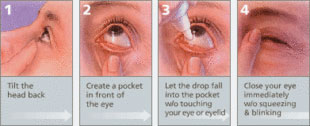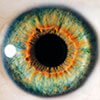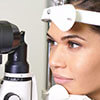How to Use Eye Drops
Tips For Using Eye Drops
Infections, inflammation, glaucoma and many other eye disorders are treated with eye drops. Surprisingly, even the small amount of medication in an eye drop can create significant side effects in other parts of the body.
It is important to remember that all medicines have side effects. There are ways to decrease the absorption of the eye drop into the system and to increase the time the eye drop is on the eye, making the medicine more safe and effective.
Inserting eye drops may seem difficult at first but becomes easier with practice.
Using Eye Drops
To put in an eye drop
- Tilt your head back.
- Create a pocket in front of your eye by pulling down the lower lid with your index finger or gently pinching the lower lid outward with your thumb and index finger.
- Let the drop fall into the pocket without touching your eye or eyelid (to prevent contamination of the bottle).
- Close your eyelids without squeezing and blinking.

How to Use Eye Drops
Immediately after instilling the drop
- Hold your forefinger against the corner of your eye near the nose, without pressing on the eye. This prevents most of the drop from traveling down the tear duct to the rest of the body.
- Keep your eyes closed for at least one minute after instilling the drop. Because the volume of a single drop exceeds the capacity of the surface of the eye, it serves no purpose to use two drops at the same time.
- Before opening your eyes, dab unabsorbed drops and tears from the closed lids with a tissue.
If you are taking two different types of eye drops, wait at least five minutes before instilling the second drop.









